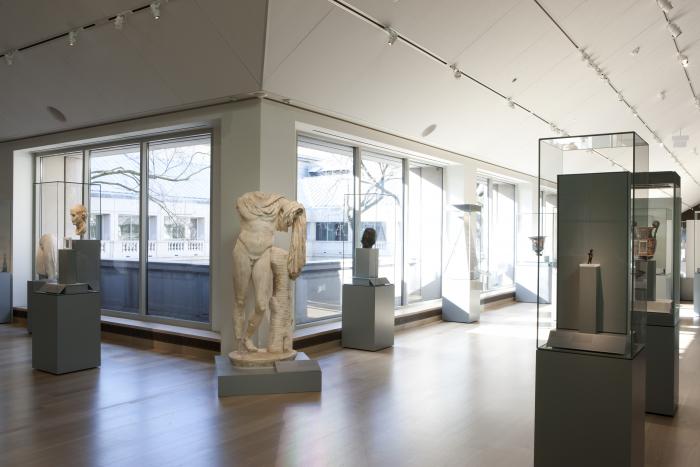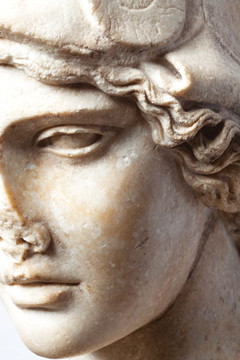Chicago-Part Three.
Beauty is Truth; Truth Beauty....
Today is my 150th post. I am amazed at how quickly the time has flown by, excited at how much I enjoy writing and photography, and most of all, deeply humbled that you are willing to share a few minutes each day with me. I love getting up each morning and giving you a glimpse into my life and, like my grandmother, sharing a poem to savor during the day. Thank you for your presence and your support.
Before we leave the Art Institute let's take a few minutes to explore the special exhibit titled Of Gods and Glamour, Greek, Roman and Byzantine Art. Over 550 works spanning 4,000 years from the Mediterranean region present the origins and early development of Western art from the dawn of the third millennium B.C. to the time of the great Byzantine Empire. Key pieces include a rare Mesopotamian Statuette of a Striding Figure (@ 2800 B.C.). My friend and I wandered from showcase to showcase, admiring beautifully decorated Greek vases, Etruscan bronze and terracotta, realistic Roman portraiture, intact and complex mosaics from near Pompeii, and finally Byzantine art. The very end of the exhibit was breathtaking, featuring 51 of the finest artworks on loan from the British Museum's collection of late Roman and early Byzantine treasures. It was fascinating to get a glimpse into the opulent households and ecclesiastical sites that existed between A.D. 350 and 650. It was also somehow reassuring, in this present time of tumult and change, to realize that family life thousands of years ago was in many ways just like today--people cared about their homes, enjoyed their families, worshiped their God (or gods) and celebrated life.
It took over two years to bring this exhibit to life, including completely revamping the courtyard with special windows, baffles and lights to best protect and showcase the art. The display cabinets were designed in Milan, and the curators worked closely with the British Museum and many private collectors in order to present a complete picture of this time period. Many of the items from England have never been displayed before and when this exhibit closes, this rare opportunity to appreciate first hand this incredible collection will close forever. I felt very lucky.


 | ||||||
| Roman Bust of Athena (detail), c. 2nd century A.D. |
Roman bust of Silenus, 1st century B.C.
There were a lot of poems I could use today, and perhaps my choice is a little obvious, but I decided to use it for two reasons: first, because the lines kept running through my head while I was walking through the exhibit, stopping to admire ancient serving bowls, urns and drinking cups, and second, because even if it is a predictable choice, it is simply too beautiful of a poem to not enjoy. I hope you like it too.
Ode on a Grecian Urn
John Keats
Thou still unravish'd bride of quietness,
Thou foster-child of silence and slow time,
Sylvan historian, who canst thus express
A flowery tale more sweetly than our rhyme:
What leaf-fring'd legend haunts about thy shape
Of deities or mortals, or of both,
In Tempe or the dales of Arcady?
What men or gods are these? What maidens loth?
What mad pursuit? What struggle to escape?
What pipes and timbrels? What wild ecstasy?
Heard melodies are sweet, but those unheard
Are sweeter; therefore, ye soft pipes, play on;
Not to the sensual ear, but, more endear'd,
Pipe to the spirit ditties of no tone:
Fair youth, beneath the trees, thou canst not leave
Thy song, nor ever can those trees be bare;
Bold Lover, never, never canst thou kiss,
Though winning near the goal yet, do not grieve;
She cannot fade, though thou hast not thy bliss,
For ever wilt thou love, and she be fair!
Ah, happy, happy boughs! that cannot shed
Your leaves, nor ever bid the Spring adieu;
And, happy melodist, unwearied,
For ever piping songs for ever new;
More happy love! more happy, happy love!
For ever warm and still to be enjoy'd,
For ever panting, and for ever young;
All breathing human passion far above,
That leaves a heart high-sorrowful and cloy'd,
A burning forehead, and a parching tongue.
Who are these coming to the sacrifice?
To what green altar, O mysterious priest,
Lead'st thou that heifer lowing at the skies,
And all her silken flanks with garlands drest?
What little town by river or sea shore,
Or mountain-built with peaceful citadel,
Is emptied of this folk, this pious morn?
And, little town, thy streets for evermore
Will silent be; and not a soul to tell
Why thou art desolate, can e'er return.
O Attic shape! Fair attitude! with brede
Of marble men and maidens overwrought,
With forest branches and the trodden weed;
Thou, silent form, dost tease us out of thought
As doth eternity: Cold Pastoral!
When old age shall this generation waste,
Thou shalt remain, in midst of other woe
Than ours, a friend to man, to whom thou say'st,
"Beauty is truth, truth beauty,—that is all
Ye know on earth, and all ye need to know."
No comments:
Post a Comment